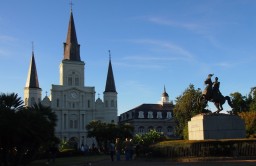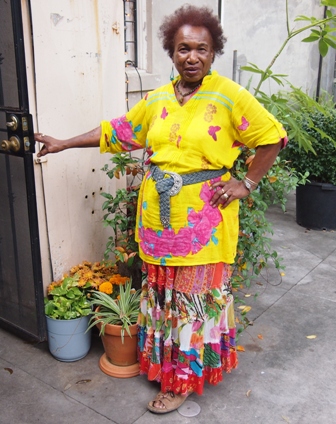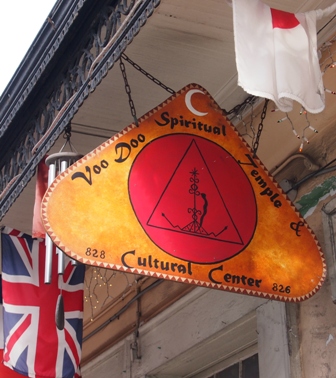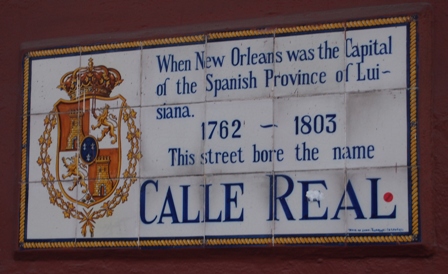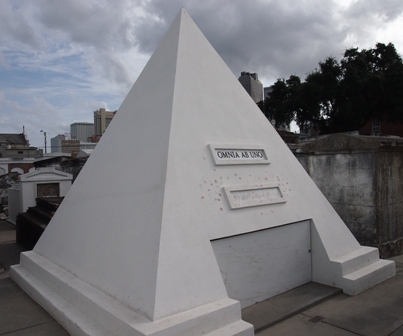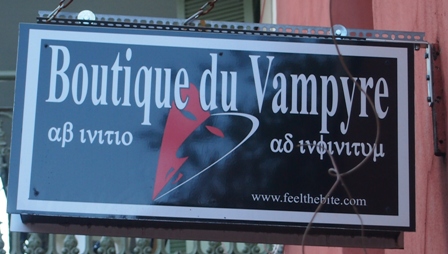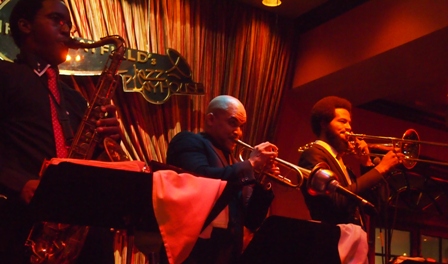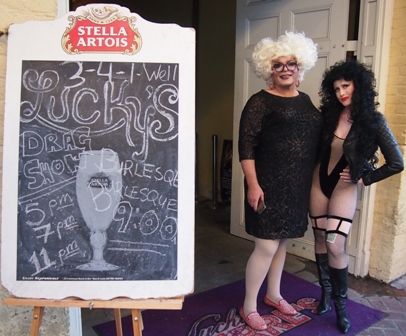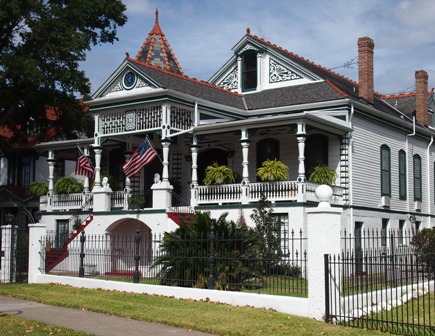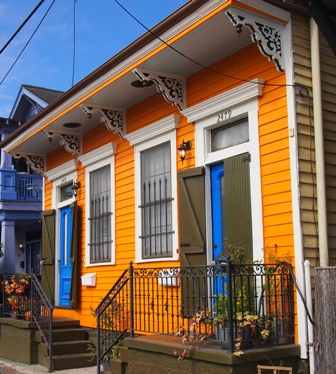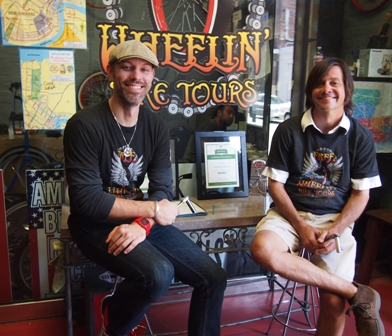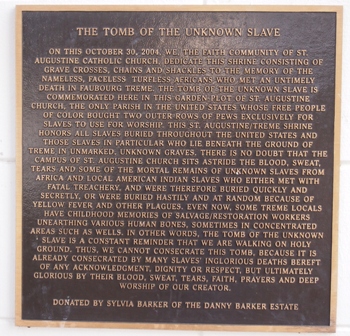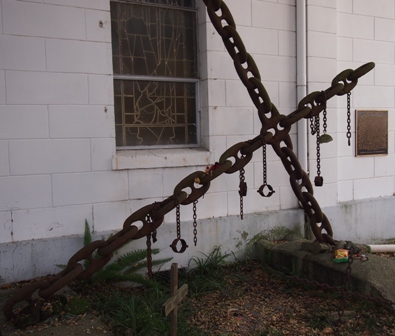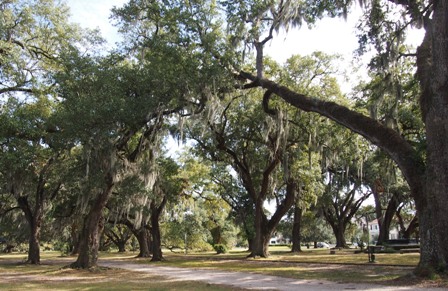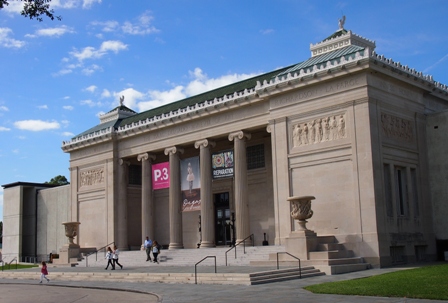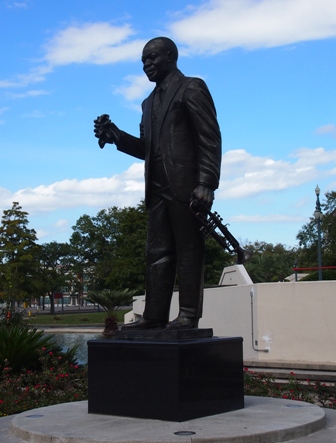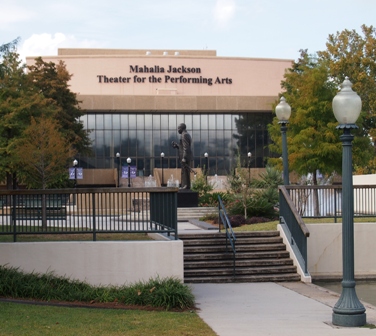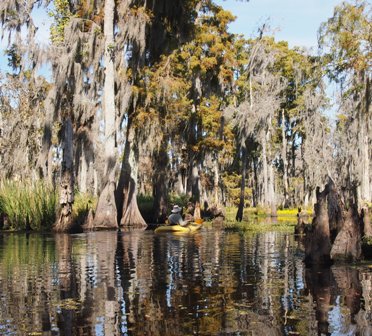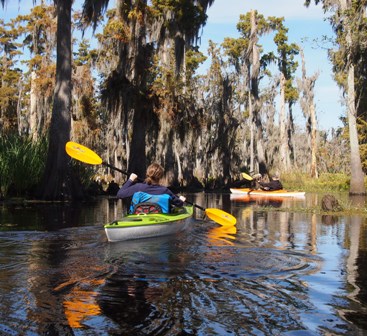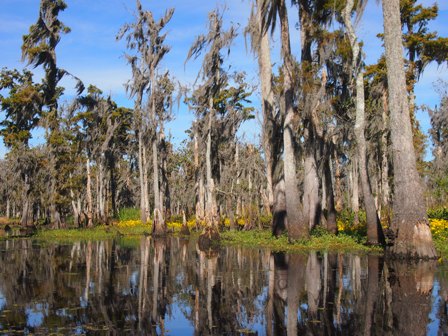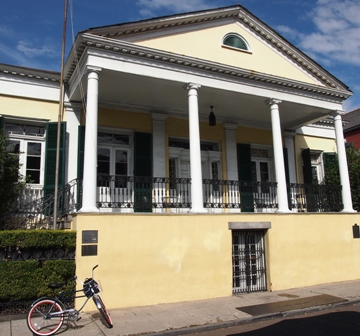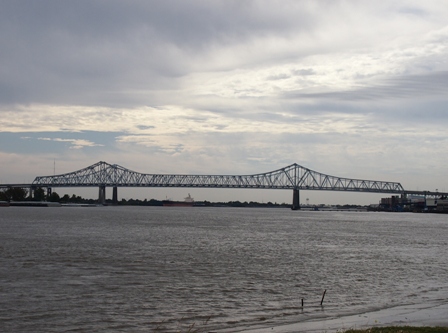New Orleans is the voodoo capital of the USA, a city where the dead are buried above ground and the past is lived in the now.
For a woman in her mid 70s she’s surprisingly youthful. Graced with a virtually unlined face despite years of struggle with untimely death and loss, she’s a bright-eyed testament to the vitality of her voodoo faith.
For many, the word voodoo conjures up vivid images of death cults, ritual sacrifice and downright spookiness. In New Orleans, voodooism is a widely accepted religion, densely woven into the fabric of this richly coloured city, a creed practiced openly by a significant minority of its citizens.
Priestess Miriam Chamani is the founder and Queen Mother of the Voodoo Spiritual Temple and Cultural Center. She cuts a striking figure dressed in a flowing skirt of many hues, a top to match and eyes that seem always in sharp focus.
A conversation with Priestess Miriam is manifold with parables. You don’t so much as chat as listen while she poses questions about the meaning of life and death following one question with another that may, or may not, answer her previous question. Her wisdom is offered in circular patterns, always returning to a central tenet, the importance of love and acceptance for all people no matter the religion or race and that life will go on while the dead are remembered.
In her eclectically decorated temple, Miriam works her magic. Currency notes from round the world are pinned to a bewildering array of small shrines dedicated to just about every major religion. Paintings of saints adorn walls of numerous small rooms.
Attempting to take it all in, in just one corner of one room I saw a small stuffed alligator, beaded figures and ceramic figures ranging from a kitsch Jesus to an old photo of who I think was Albert Schweitzer.
But I didn’t see a voodoo doll festooned with pins anywhere.
Her inner sanctuary contains a desk overrunning with curios, crucifixes and divining bones. A computer is nearly hidden amongst the assortment, like an afterthought to 21st century connections.
Before meeting Priestess Miriam I’d been on a walk with Robert Florence of Cemetery Voodoo Tours (www.tourneworleans.com). Florence is the author of New Orleans Cemeteries and City of the Dead, two authoritative books about how New Orleans has dealt with human mortality unlike anywhere else in the USA. He is also one of New Orleans top-rated guides. His ancestors also happen to be buried in New Orleans’ St Louis Cemetery #1.
Voodoo as practiced by Priestess Miriam reflects contemporary society’s attitude towards laissez-faire belief systems with lots of New Age influences. Borrowing like a magpie from most of the world’s main religions, her voodooism spreads the word via simple messages about love, eternal truth and the holy spirits. She also tells fortunes, spruiks natural healing and travels the world helping set up other voodoo chapters. Her latest project has been establishing a Russian branch of her temple.
(Update: Sadly an electrical fire damaged Mother Miriam’s temple 1 February 2016. Check www.voodoospiritualtemple.org before arranging a visit. Thankfully, no one was hurt.)
We had spent hours exploring the St Louis Cemetery #1 reading tombstones from early French settlers to Spanish conquistadors to German merchants, Irish, English and Scotch pioneers before visiting Priestess Miriam’s temple.
Established in 1789 when the Spanish government still ruled New Orleans, it’s the city’s oldest cemetery still in existence. By the late 18th century, New Orleans’ great St Louis cathedral needed more space in which to bury its parishioners. The city had grown from a colonial backwater French town into the new country’s greatest commercial cosmopolitan city after New York. When Napoleon sold Louisiana to the USA in 1803 to help fund his empire building in Europe, New Orleans subsequently became the gateway city to the vast new land acquisition, replete with untapped wealth and lots of room for new settlers.
An earlier established cemetery, St Peter Street Cemetery was made redundant due to overcrowding in 1788 when over 80% of New Orleans burnt to the ground and approximately 1,200 people were killed. A new cemetery was created in boggy ground near the Basin St canal, the St Louis Cemetery #1. There are three St Louis Cemeteries around New Orleans today, but #1 is by far the most famous and most centrally located.
St Louis Cemetery #1 is the city’s prime burial ground. Many of the city’s most famous citizens are interred there, almost all above ground.
New Orleans’ marshlands impede burying the dead six feet under. Bodies in shallow graves tend to rise up out of sodden earth after a hurricane or severe flood. Consequently New Orleans’ cemeteries are an assembly of tightly packed mausoleums. This is the widely accepted explanation for above ground burial. The real reason was lack of space and the Catholic Church’s prohibition of cremation.
Resourceful morticians solved the problem of overcrowding the mausoleums by devising a uniquely New Orleans’ solution to the problem. The corpses are placed in wooden coffins, stuffed into the mausoleum for a traditionally allotted period of one year and one day, by which time the remains have ‘cooked’ in New Orleans’ sultry heat and been rendered into ash and bone, the wood almost completely rotted. The mausoleum is reopened after the officially tallied 366 days have passed. The wooden remnants are removed while the body’s remains are brushed to the rear of the chamber where they fall into an empty space discretely fitted to the back of the mausoleum thereby leaving the now empty shelf free for another corpse, an efficient though somewhat gruesome disposal of the dead.
Voodoo adherents honour their dead. Having evolved from a mixture of African animism, Catholicism and Pantheism, contemporary voodoo sanctifies life in equal measure to death. Links to Mexico’s Day of the Dead celebrations every 2nd of November are clear, New Orleans is separated from Mexico by only a short trip across the Gulf of Mexico after all.
One of the most famous tombs in St Louis Cemetery #1 is the Voodoo Queen’s, Marie Catherine Laveau.
Laveau was a spiritual healer of African ancestry. Word of her expertise with herbal remedies combined with her sympathetic nature (and smart business acumen) spread like a Mississippi flood throughout New Orleans where she was a celebrated figure until her death in 1881 aged 80. Her exact birth date is unknown but it’s reckoned she was born in New Orleans in 1801. Like so many New Orleans’ celebrated figures, Marie Laveau’s life is a riddle of fact and fiction. She was a hairdresser, a liquor importer (bootlegger) and brothel owner.
She is now New Orleans’ most famous Voodoo Queen and her tomb in the St Louis Cemetery #1 is the most visited.
Offerings of food and drink are constantly left at her mausoleum, keeping the cemetery maintenance workers busy cleaning up the detritus. Florence disparaged the fast food offerings as an insult to her memory and complained that people had no sense if they thought fried chicken would honour her memory, ‘It just attracts rats,’ he said.
His comments about the actor Nicholas Cage’s tomb were equally critical. The Cage mausoleum is an ostentatious pyramid very unfitting when compared to the neo-Classical edifices surrounding it. Cage made a film in New Orleans, became infatuated with the place and decided he would be buried there. Florence commented that ‘He bought a number of homes here, too many by all accounts, made bad investments, sold some of them but kept this silly tomb.’
Having spent hours on a fascinating walk amongst the living dead of the St Louis Cemetery #1and in the company of an authentic Voodoo Priestess, I can honestly say there’s more fiction than fact surrounding the reality of doing voodoo for a day in New Orleans but the facts are a hell of a lot more interesting.
Naked Tip: New Orleans boasts several commonly used nicknames: N’awlins, NOLA (New Orleans, LA (LA is the state of Louisiana’s official abbreviation) The Big Easy and the Crescent City.
NOLA is of course also famous for its nightlife, perfect for zombie inducing fantasies while the undead prefer moonlight over sunlight.
Grammy and Billboard award winner Irvin Mayfield hosts an improv jazz show Wednesday nights at the Royal Sonesta hotel in the French Quarter (300 Bourbon St. www.sonesta.com/royalneworleans) where budding new talent is invited to join the master on the small stage. Bookings are obligatory for this quintessential jam session.
Nearby the French Quarter is the Faubourg Bywater-Marigny district where in and around Frenchmen St. numerous jazz clubs draw in regular crowds of N’awlins’ style music. Heavy on brass, rich in history, soul and bravado, it’s the thumping beat of the Big Easy. Most clubs start hopping after 10pm. Cover charges if any are minimal. For the price of a drink, you get a memorable show.
By the way, both Sazerac and Hurricane cocktails were invented in NOLA. The former is a simple blend of rye whisky, bitters and absinthe, the latter a mix of dark and light rums, one of them overproof, Grenadine, passion fruit juice and lemon. Both are potent; you have been warned.
The love of food is the passion that drives this old city. Creole (a mix of Spanish, Native American and African), Cajun (French Canadian and Dixie) dominate the indigenous food culture.
The French Market near the river, oldest of its kind in the USA, spanning six blocks at the bottom of the French Quarter is open daily. Once a small meat market spread around the equally famous Cafe du Monde, it expanded over the years to encompass a long covered arcade packed with food stalls, produce carts, tourist shops and some of the best people watching in town. The freshly shucked oysters served with lemon wedges, crackers and Tabasco sauce were my top pick. (Tabasco sauce is made in Cajun country approximately two hundred kilometres west of New Orleans on Avery Island. Daily tours are highly recommended www.tabasco.com)
New Orleans is full of terrific restaurants, far too many to list here. Some are clearly best avoided dives (the west end of Bourbon St is the main tourist zone, suffering from a surfeit of cheap looking bars with overpriced bad food) while many are cutting edge bonanzas of produce driven excellence.
From plain down home cafes where fried chicken is so popular that queues begin snaking around the block well before lunch time (such as the fabulous Willie Mae’s Scotch House in operation since 1957, 2401 St. Ann St or Dooky Chase’s Restaurant, 2301 Orleans Ave.) to upscale palaces where service is sublime, the drinks powerful and the food exquisite.
Naked Tip: My top pick is the Commander’s Palace in the Garden District, a street car named desire’s ride from the CBD, 1403 Washington Ave www.commanderspalace.com operating since 1880 and in the same family hands since early last century. Book first!
This is a city where the inhabitants are led by their nose directly to their stomachs.
Naked Tip: Ask a local foodie or the concierge at your hotel for what’s hot at the moment. Preferences change faster than shoes on a Milan fashion show runway.
Bicycling is a terrific way to explore this flat-as-a-crepe city. I joined an excellent bike tour offered by FreeWheelin’ Bike Tours led by a friendly guide whose knowledge of NOLA was encyclopaedic, shared freely while interspersed by witty jokes. Taking in NOLA’s most historic sights during a half day’s easy pedalling was truly laissez les bons temps roulez. (See www.neworleansbiketour.com 325 Burgundy St. in the French Quarter, for a complete listing of their daily tours.)
During the half day’s pedalling around NOLA, we stopped at the heart-breaking Monument to the Unknown Slave in the Marigny District. New Orleans, along with Charleston, SC operated one of the two largest slave markets in pre-Civil War USA.
From the Marigny and Bywater Districts we headed up to the glorious City Park, 50% larger than New York’s Central Park and one of the oldest in the USA. With its New Orleans Museum of Art and hundreds of live oak trees (some over 600 years old), it’s one of the loveliest green spaces around.
On the way back to the French Quarter we stopped in Rampart St to visit the Mahalia Jackson Theater for the Performing Arts with an iconic statue of Louis Armstrong in the forecourt. A show here is a must-do experience while in New Orleans.
Lost Land Tours (www.lostlandtours.org) run kayak trips in threatened eco-systems closest to New Orleans. Small group tours (no more than six people) are conducted by well trained experts in ecology, wildlife and the state’s dubious reputation for environmental mismanagement. (The US Army Corps of Engineers constructed so many levees that New Orleans’ very existence is under real jeopardy from inundation due to encroaching waters from the Gulf of Mexico.)
One of the best days I spent in this city unlike any other in the USA was while paddling ten kilometres up and down an eerily quiet bayou north of the CBD just west of Lake Pontchartrain. The peace was interrupted by alligators splashing off logs, bald eagles occasionally screeching overhead, turtles plopping from muddy banks into still water and flocks of herons, wings flapping lazily above. Paddling waist height, gliding silently through the ebony coloured bayou surrounded by goldenrod, lilies, wild orchids and irises, looking out for wildlife… was a wonder.
This experience is all about education; it’s not a ‘gator hunt’ like other operators spruik to attract gawking tourists, a thoroughly authentic immersive and educational experience.
New Orleans offers a variety of walking tours. I recommend a Garden District architectural tour to get a better idea of what this alternative to the French Quarter’s sometimes maddening tourist scene offers. Tres elegant in parts, raffish in others, the Garden District provides a rich chocolate box array of grand houses, gracious public squares surrounded by oak trees draped in Spanish moss and a hodge-podge of trendy boutiques and fashionable cafes. See www.neworleans.com/tours/shop/garden-district for more information.
New Orleans is a city everyone should visit at least once.
That being said, I dare you to limit your visits to just one.
Tom Neal Tacker visited New Orleans as a guest of the New Orleans CVB.
Naked Facts:
www.neworleanscvb.com is a one-stop shop for general tourism inquiries about New Orleans.
Naked Routes:
Louis Armstrong New Orleans International Airport is approximately 19 kilometres west of the city’s downtown and adjoining French Quarter. Most major USA based airlines offer frequent connections to New Orleans from their hub airports.
Naked Sleeps:
The Le Richelieu is an historic boutique hotel ideally located in Chartres St (pronounced ‘Charters’) at the eastern and more peaceful residential end of the French Quarter, very close to the French Market and numerous cafes, restaurants and shops. Unusual for New Orleans’ small hotels it boasts a large swimming pool and garden. Rooms are decorated in 19th century period style, a mix of French and Spanish neo-Classical furnishings with contemporary flourishes. See www.lerichelieuhotel.com

